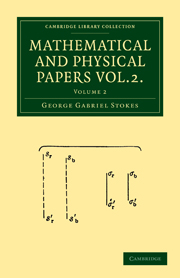Book contents
- Frontmatter
- Contents
- Notes on Hydrodynamics. III. On the Dynamical Equations
- On the constitution of the Luminiferous Ether
- On the Theory of certain Bands seen in the Spectrum
- Notes on Hydrodynamics. IV. Demonstration of a Fundamental Theorem
- On a difficulty in the Theory of Sound
- On the Formation of the Central Spot of Newton's Rings beyond the Critical Angle
- On some points in the Received Theory of Sound
- On the perfect Blackness of the Central Spot in Newton's Rings, and on the Verification of Fresnel's Formula for the intensities of Reflected and Reflacted Rays
- On Attractions, and on Clairaut's Theorem
- On the Variation of Gravity at the Surface of the Earth
- On a Mode of Measuring the Astigmatism of a Defective Eye
- On the Determination of the Wave Length corresponding with any Point of the Spectrum
- Discussion of a Differential Equation relating to the Breaking of Railway Bridges
- Notes on Hydrodynamics, VI. On Waves
- On the Dynamical Theory of Diffraction
- On the Numerical Calculation of a class of Definite Integrals and Infinite Series
- On the Mode of Disappearance of Newton's Rings in passing the Angle of Total Internal Reflection
- On Metallic Reflection
- On a Fictitious Displacement of Fringes of Interference
- On Haidinger's Brushes
- Index
On a Fictitious Displacement of Fringes of Interference
Published online by Cambridge University Press: 07 September 2010
- Frontmatter
- Contents
- Notes on Hydrodynamics. III. On the Dynamical Equations
- On the constitution of the Luminiferous Ether
- On the Theory of certain Bands seen in the Spectrum
- Notes on Hydrodynamics. IV. Demonstration of a Fundamental Theorem
- On a difficulty in the Theory of Sound
- On the Formation of the Central Spot of Newton's Rings beyond the Critical Angle
- On some points in the Received Theory of Sound
- On the perfect Blackness of the Central Spot in Newton's Rings, and on the Verification of Fresnel's Formula for the intensities of Reflected and Reflacted Rays
- On Attractions, and on Clairaut's Theorem
- On the Variation of Gravity at the Surface of the Earth
- On a Mode of Measuring the Astigmatism of a Defective Eye
- On the Determination of the Wave Length corresponding with any Point of the Spectrum
- Discussion of a Differential Equation relating to the Breaking of Railway Bridges
- Notes on Hydrodynamics, VI. On Waves
- On the Dynamical Theory of Diffraction
- On the Numerical Calculation of a class of Definite Integrals and Infinite Series
- On the Mode of Disappearance of Newton's Rings in passing the Angle of Total Internal Reflection
- On Metallic Reflection
- On a Fictitious Displacement of Fringes of Interference
- On Haidinger's Brushes
- Index
Summary
The author remarked that the mode of determining the refractive index of a plate by means of the displacement of a system of interference fringes, is subject to a theoretical error depending upon the dispersive power of the plate. It is an extremely simple consequence (as the author shewed) of the circumstance that the bands are broader for the less refrangible colours, that the point of symmetry, or nearest approach to symmetry, in the system of displaced fringes, is situated in advance of the position calculated in the ordinary way for rays of mean refrangibility. Since an observer has no other guide than the symmetry of the bands in fixing on the centre of the system, he would thus be led to attribute to the plate a refractive index which is1 slightly too great.
The author has illustrated this subject by the following experiment. A set of fringes, produced in the ordinary way by a fiat prism, were viewed through an eye-piece, and bisected by its cross wires. On viewing the whole through a prism of moderate angle, held in front of the eye-piece with its edge parallel to the fringes, an indistinct prismatic image of the wires was seen, together with a distinct set of fringes which lay quite at one side of the cross wires, the dispersion produced by the prism having thus occasioned an apparent displacement of the fringes in the direction of the general deviation.
- Type
- Chapter
- Information
- Mathematical and Physical Papers , pp. 361Publisher: Cambridge University PressPrint publication year: 2009First published in: 1883

